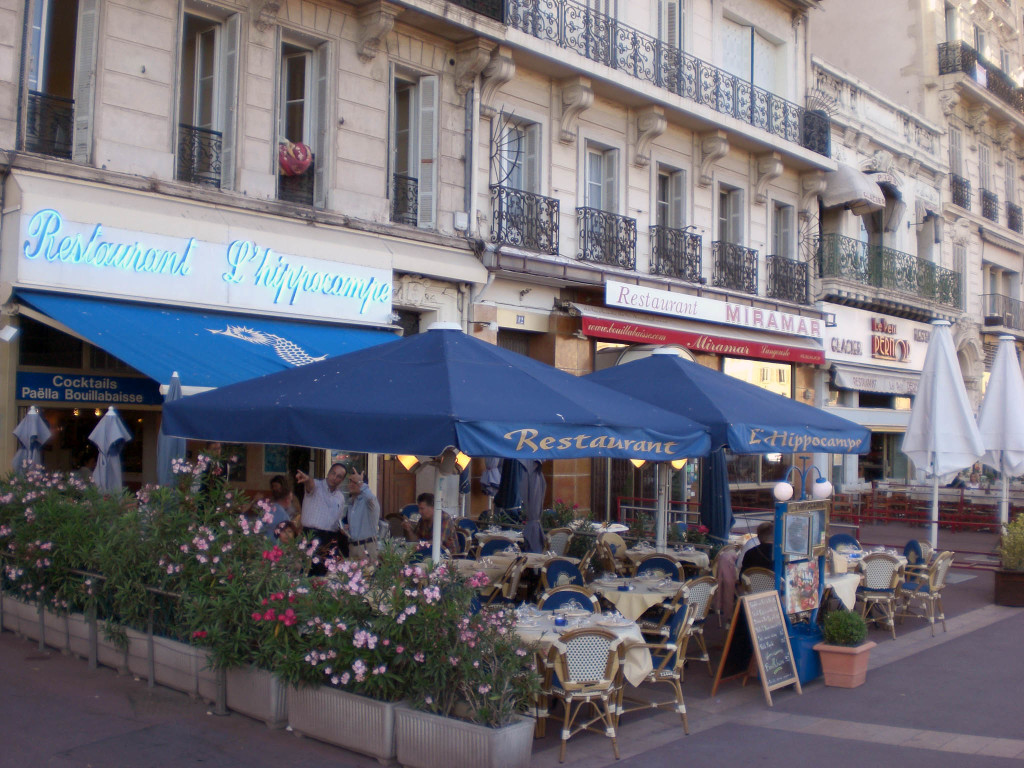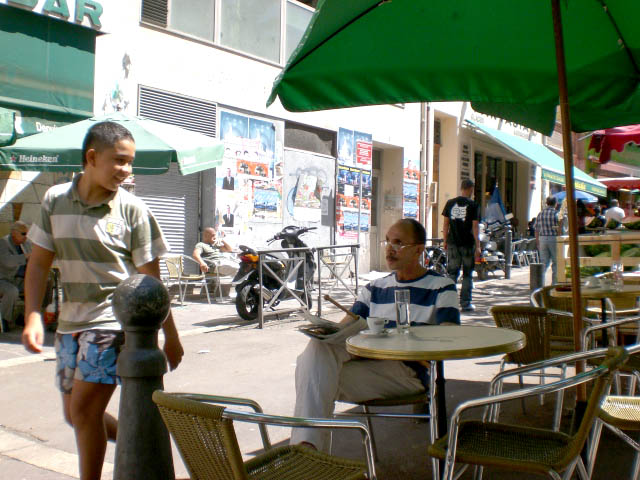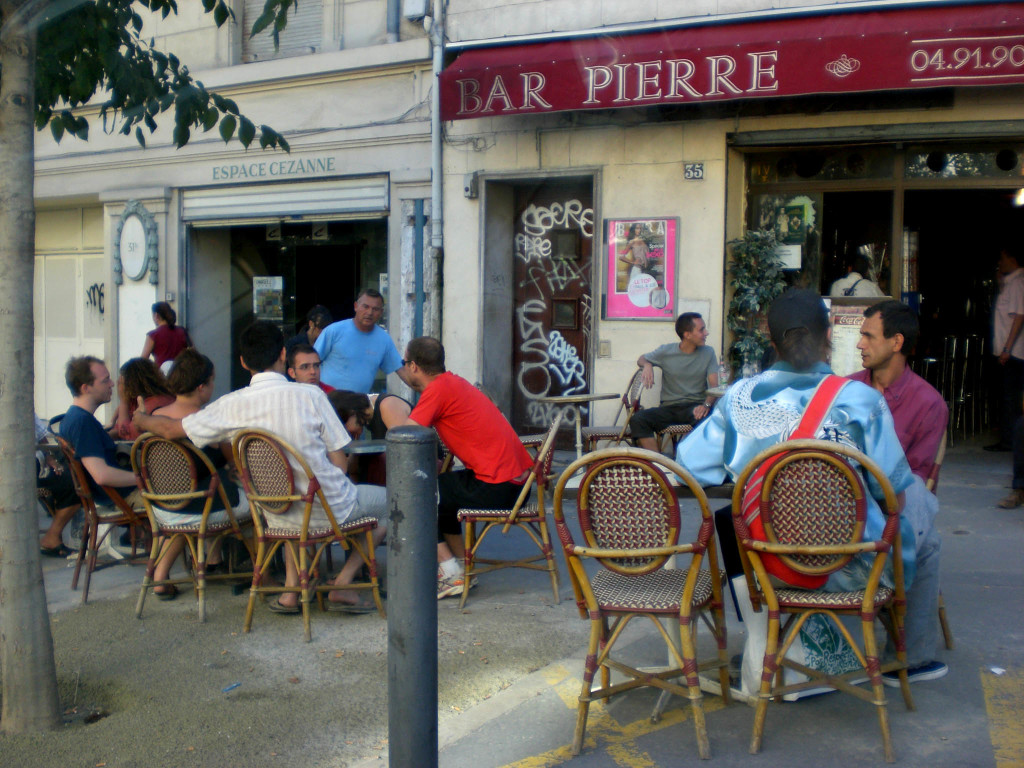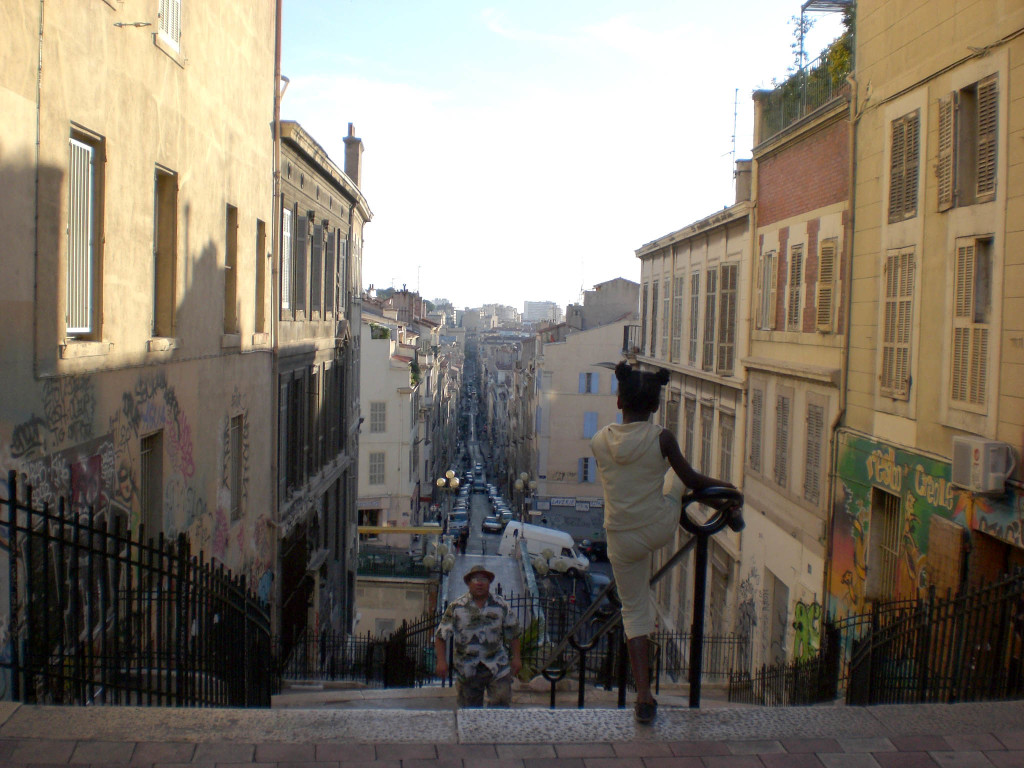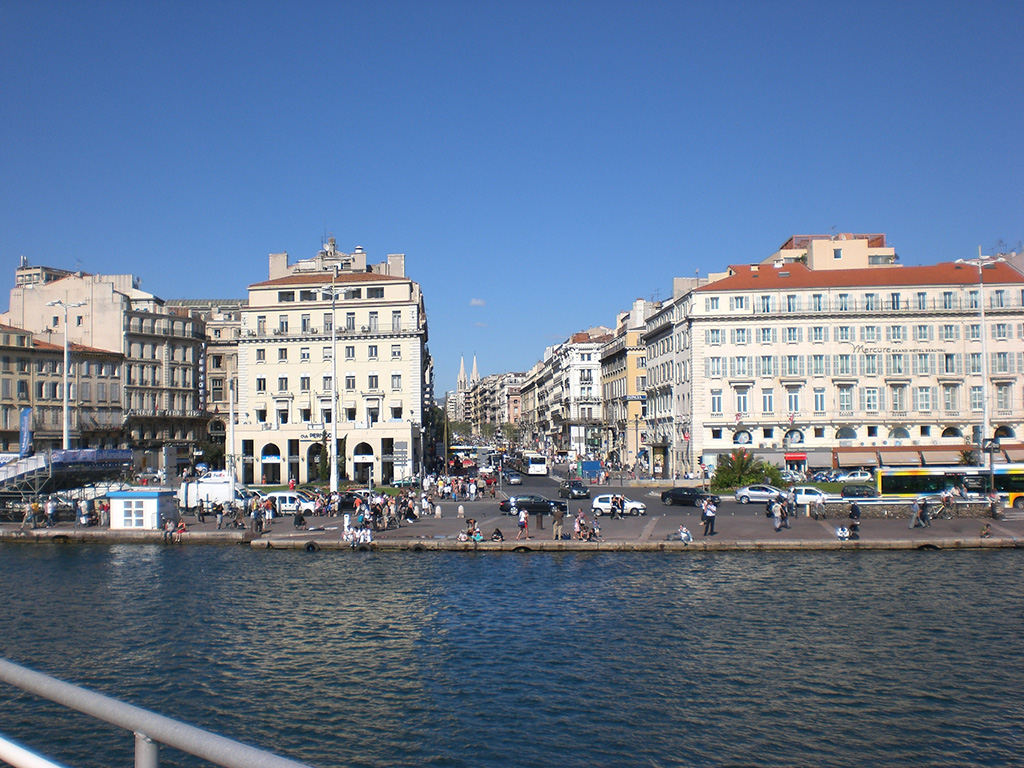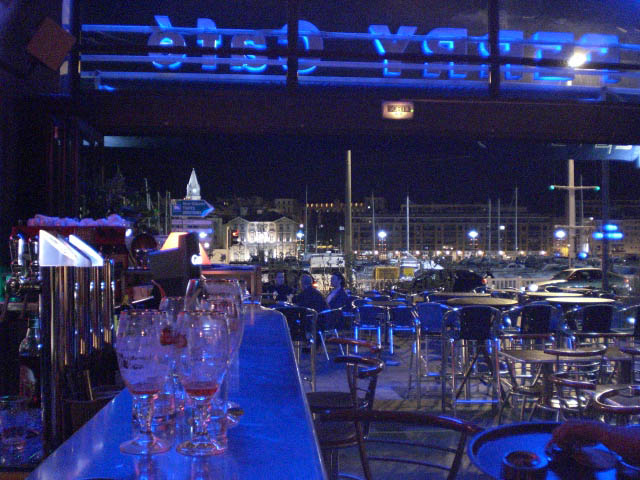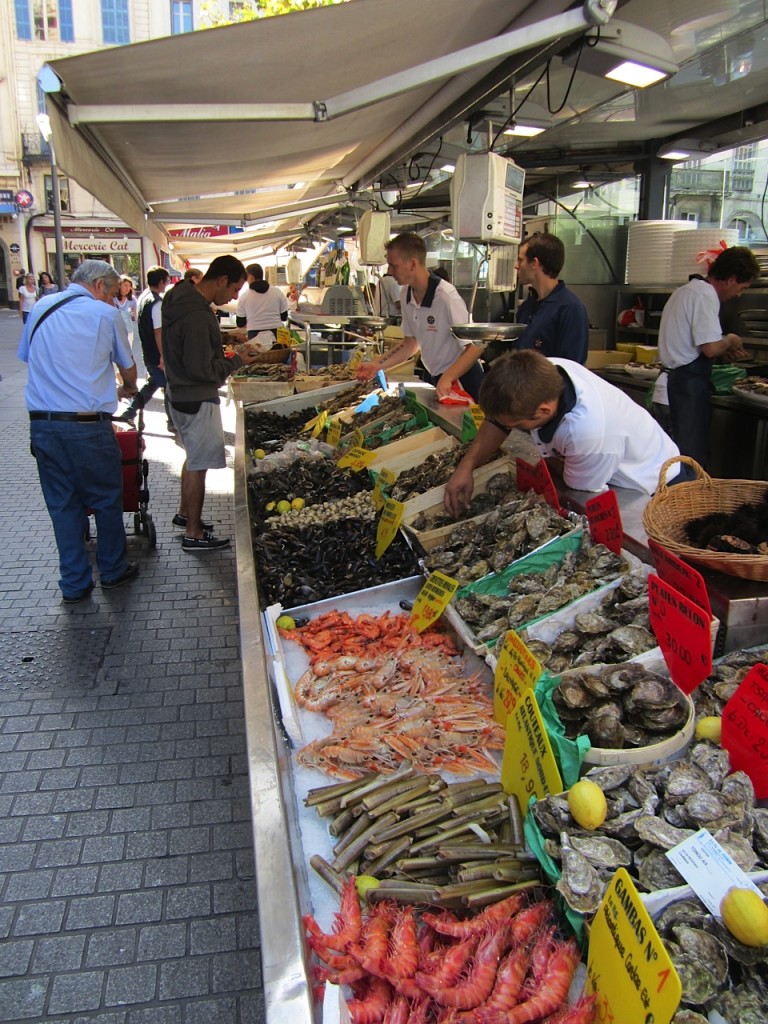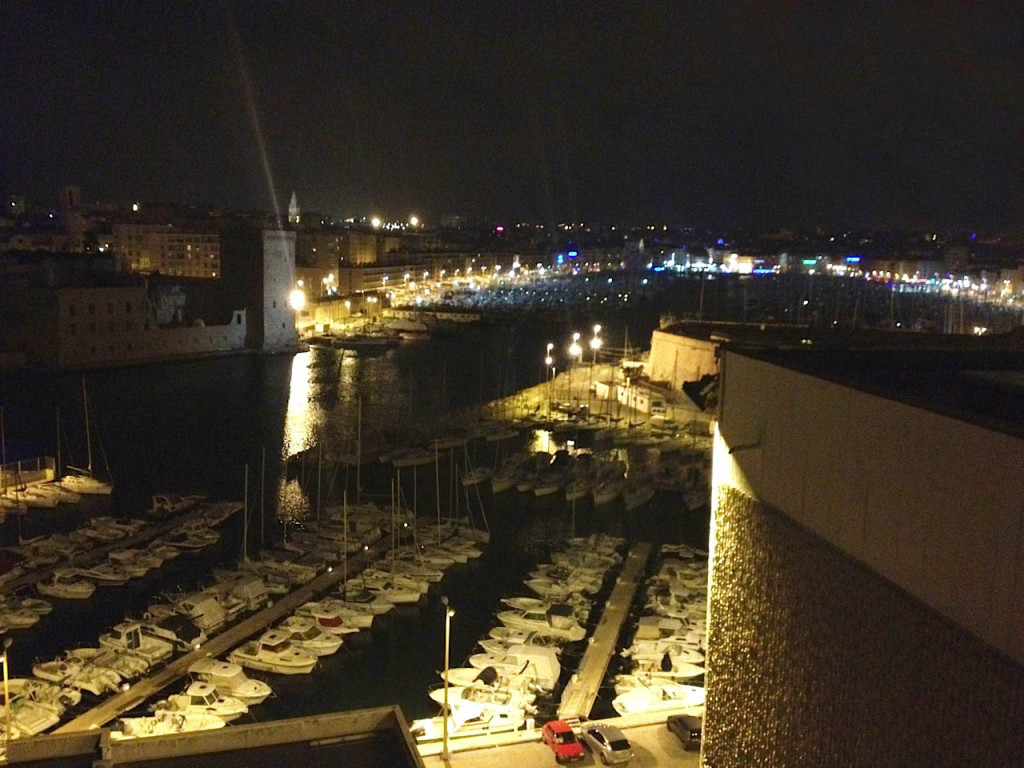In every seaside city, fishermen’s families have always thought out to prepare main courses using leftovers from unsold fishing (fish of scarce quality, fish way to small to be sold or too heterogeneous, crustacean and mollusks caught in the fishing net).
But when no less that ten different varieties of fish and crustaceans work it out together to make up a soup seasoned with pepper, fennel seeds and parsley, dressed with garlic, onion, tomato and olive oil, generously reduced with Pastis and made irresistible by the golden orange of saffron, then this is way far from the popular home cooking. Even the mise en place is a prelude to a ritual that is celebrated by spreading bread croutons with a sauce as thick as mayonnaise and seasoned with garlic, saffron, paprika from Occitan, la rouille; croutons can be served aside or may also be sunk in the soup, likewise the finest fish fillets can be served aside, thus giving all guests the choice to personalize their own plate. To exalt all ingredients in a perfect osmosis, the soup needs to be cooked for a long time over a low heat: simmering is the secret for a perfect bouillabaisse.
Restaurants along the northern front of the Vieux-Port. Their common denominator is the bouillabasse.
The soup has the same origins of its city, Marseille: both of them can be dated back to Phoceans, Greek sailors with known skills of overseas trading and founders of whole cities, that loved cooking the kakabìa using leftovers from the fishing.
As intense and pungent is the scent of bouillabaisse, likewise the taste of Marseille is a strong smell of harbor.
A bit of relax in one of the bars with outdoor seating in the heart of the street market of the historic centre.
Marseille was conceived as a maritime harbor, and ever since it has never stopped functioning as port. The harbor of Marseille was, and still is, one of the busiest port of the Mediterranean basin: in modern times shipment for the colonial conquests of an Empire as big as one tenth of the whole world departed from Marseille; raw materials and refined goods produced by the colonies were shipped to mother country through Marseille; the returning flow of the pieds noirs poured in Marseille after the decolonization between the 50’s and the 60’s. Inside the city center, several different ethnic groups settled, thus contributing to the foundation of more cities within the city, making it so crowded that counts more than 3.500 citizens for km2: a crowd of cultures, lifestyles and ethnic group that would otherwise be unbearable in any other city, but that in Marseille turns into poetry.
The Atmosphere of Parisienne Bars with outdoor seating frequented by Pieds-noirs along the Canebière.
It is easy to guess that due to all this flow of people and goods – despite of the delicate nuance of the homonymous soap – Marseille “stinks”.
In the light of this, the public administration has started up a deep process of urban renewal, intervening on the quality of the environment, improving accessibility to public services, strengthening real estate and market offering and restyling urban imaging (the project Euroméditerranée, the greatest operation of urban planning carried on in Europe, has permitted the requalification of 480 hectares of urban area). These deep activity of renewal, the way creativity was expressed, the great potential of resources, earned the city the title of European Capital of Culture 2013.
Historic centre of Marseille.
The Vieux-Port is the beating heart of the city, a long and deep marine creek that extends into the historical center. In the port hundreds of activities go on night and day. The original labyrinth-shaped tiny streets characteristic of Vieux-Port neighborhoods, nest for – according to Nazis – criminals of any kind, became target of the bombing that in 1943 destroyed the whole harbor waterfront and that had as duty to purify Marseille, “the cancer of Europe”.
Canebière street, which connects the Vieux-Port with the quarters of the rope factories.
Nowadays, the Vieux-Port’s waterfront, underneath the porches, reconstructed according to Pouillon e Perret’s project, is even more lively: along the northern seaside there are restaurants, bars, local food & souvenirs shops that run one after the next with no interruption, showing off the most beautiful and finest enogastronomic delicacies of Marseille. Bars tempt passers-by to refresh their throats with a glass of Pastis or with a bottle of “La Cagole”, la bier du Cabanon, while the golden shimmering light of bouillabaisse lights up restaurants.
Nightclub in the southern front of the Vieux-Port.
On the other side of the harbor, the southern waterfront offers the most intriguing and hidden walkways. Here again, restaurants thickly follow each other offering all the richness of the fish market of a nation that has the luck of facing two different seas: next to the tasty and delicate fish caught in the Mediterranean sea, infinite varieties of oysters and mighty crustaceans coming from the North Sea and the Atlantic Ocean can be found. Right for its nature of authentic seaport, opposites bump into each other on a daily basis: after drinking a Ceres Stout in an Irish pub, you can drink the white beer, compulsorily served with a slice of lemon, outdoor on the benches of the harbor, with the tinkling sound of sail ropes hitting the masts; next to the amber lights of restaurants for tourists and families, pinkish lights filter from sex clubs and the alcoves of prostitutes, who have ever since been the queens of harbors.
The Toinou’s fish market in Cours Saint-Louis offers the finest variety of crustaceans and molluscs (and also offers the possibility to immediately eat them in the restaurant just across the street).
Like bouillabaisse, Marseille authentically and generously express its nature of port city: it creates masterpieces using ingredients coming from the sea, seasonings from the land and its multiethnic flavors; however, the same complexity of bouillabaisse, at the limits of sensory saturation, too rich of flavors, is anyway too limited to contain and tell whole Marseille.
The Vieux-Port is the scenery of the restaurant Les Trois Forts of the Luxury Hotel Sofitel Marseille Vieux-Port.
Notes
[1] Jean-Claude Izzo, Chourmo, Il cuore di Marsiglia, 1996.
(Head image: The Vieux-Port is the scenery of the restaurant Les Trois Forts of the Luxury Hotel Sofitel Marseille Vieux-Port.)
Translated by Ester Badami
Il lato oscuro del porto
In ogni città di mare le famiglie dei pescatori si sono da sempre ingegnate a elaborare piatti a partire dai resti del pescato invenduto (pesci di scarsa qualità, troppo piccoli, troppo eterogenei, crostacei e molluschi incastrati tra le reti).
Ma quando non meno di dieci varietà di pesce e crostacei diversi collaborano insieme alla realizzazione di una zuppa aromatizzata con pepe, semi di finocchio e prezzemolo, condita con aglio, cipolle, pomodoro e olio d’oliva, sfumata generosamente con il Pastis e resa irresistibile dall’arancio dorato dello zafferano, siamo decisamente usciti fuori dal campo della cucina popolare domestica. La stessa mise en place prelude ad un rituale che si celebra spalmando su crostini di pane una salsa densa come una maionese a base di aglio, zafferano e paprica provenzale, la rouille; i crostini accompagnano la zuppa o possono tuffarvisi dentro, come le carni più pregiate dei pesci, che vengono servite a parte, dando ad ogni commensale la possibilità di personalizzare il proprio piatto. Per esaltare tutti gli ingredienti in un’osmosi perfetta la zuppa richiede una lunga cottura a fuoco lento: è il sobbollimento il grande segreto della bouillabaisse.
Ristoranti lungo il fronte settentrionale del Vieux-Port. Il loro minimo comune denominatore è la bouillabasse.
La zuppa ha le stesse origini della sua città, Marsiglia: entrambe risalgono ai focesi, quei marinai greci che erano tanto abili a commerciare navigando quanto a costruire città e che amavano preparare la kakabìa con i residui del pescato.
Come intenso e penetrante è l’aroma dellabouillabaisse, così il gusto di Marsiglia è un forte sapore di porto.
Sosta al bar con tavolini all’aperto in mezzo ad uno dei mercati delle strade del centro storico.
Nata come approdo marittimo, non ha mai smesso la sua funzione portuale. Il porto di Marsiglia è stato – ed è tuttora – uno dei più trafficati del Mediterraneo: in epoca moderna da Marsiglia sono partite le spedizioni per le conquiste coloniali di un impero vasto quasi un decimo del territorio mondiale; attraverso Marsiglia sono confluite in madrepatria le materie prime e i beni prodotti dalle colonie; a Marsiglia si è riversato il flusso di ritorno dei pieds noirs dopo la decolonizzazione tra gli anni ’50 e ’60. All’interno del centro storico si sono addensate le diverse comunità etniche che hanno contribuito a costruire città dentro la città, rendendola così densa da riuscire a far vivere più di 3.500 abitanti in un km2: un affollamento di culture, stili di vita ed etnie che sarebbe insostenibile in qualsiasi altra città, ma che a Marsiglia diventa poesia.
Atmosfere dei locali parigini con tavolini all’aperto frequentati dai Pieds-noirs lungo la Canebière.
È facile intuire che a causa di tale intenso traffico di persone e merci – a discapito della delicata fragranza del suo omonimo sapone – Marsiglia “puzzi”.
Ed è con questa consapevolezza che l’amministrazione pubblica ha avviato un profondo processo di rinnovamento urbano, agendo sulla qualità dell’ambiente, l’accessibilità ai servizi, il potenziamento dell’offerta immobiliare e commerciale, il restyling dell’immagine urbana (il progetto Euroméditerranée I e II, la più grande operazione di pianificazione urbanistica avviata in Europa, sta producendo la riqualificazione di circa 480 ha di suolo urbano). Queste intense attività di rinnovamento, la creatività espressa, le grandi potenzialità delle risorse, hanno valso alla città il titolo di Capitale Europea della cultura per il 2013.
Centro storico di Marsiglia.
Cuore pulsante della città è il Vieux-Port, una profonda insenatura marina che si allunga dentro il suo centro storico e terminale dell’asse centrale che attraversa tutta la città antica. Esso pulsa delle centinaia di attività che vi si svolgono, sia di giorno che di notte. L’originaria tessitura labirintica dei quartieri limitrofi al Vieux-Port, ricettacolo – secondo i nazisti – di criminali di ogni sorta, divenne il bersaglio del bombardamento che nel 1943 rase al suolo gran parte del fronte del porto e che aveva come obiettivo quello di purificare Marsiglia, il “cancro d’Europa”.
L’asse della Canebière che collegava il Vieux-Port con i quartieri delle corderie.
Oggi, sotto i portici degli edifici del fronte del porto, ricostruiti secondo i progetti di Pouillon e Perret, il Vieux-Port è ancora più vitale: lungo il fronte settentrionale si susseguono senza interruzione ristoranti, bar, negozi di prodotti tipici e souvenir che mettono in mostra le più belle e le più buone delizie enogastronomiche di Marsiglia. I bar invitano a rinfrancarsi dalla calura con un bicchiere di Pastis o una bottiglia di “La Cagole”, la bier du Cabanon, mentre i ristoranti, quando si allungano le prime ombre della sera, si illuminano dei bagliori dorati della bouillabaisse. È “l’ora in cui Marsiglia si agita. In cui ci si chiede quale zuppa si mangerà, la sera. Antillese. Brasiliana. Africana. Araba. Greca. Armena. Vietnamita. Indiana. Provenzale. O delle isole Réunion. C’è di tutto nel calderone marsigliese. Per tutti i gusti” [1] .
Locale notturno del fronte meridionale del Vieux-Port.
Dall’altra parte del porto, il fronte meridionale offre percorsi più nascosti e intriganti. Anche qui i ristoranti si susseguono l’uno dopo l’altro, offrendo tutta la ricchezza del mercato ittico di una nazione che ha la fortuna di affacciarsi su due mari: ai pesci saporiti e delicati del Mediterraneo si accostano infinite varietà di ostriche e crostacei monumentali provenienti dal Mare del Nord e dall’Oceano Atlantico. Come vero porto di mare, qui l’incontro tra gli opposti è la normalità: dopo una Ceres scura dentro un pub irlandese ti attende la birra bianca, con la sua immancabile fetta di limone, da bere all’aperto sulle banchine del porto, al tintinnare delle drizze delle barche a vela; accanto alle luci ambrate dei ristoranti per turisti e famiglie, filtrano le luci rosate dei locali hard e delle alcove delle prostitute, da sempre regine dei porti.
Il mercato del pesce di Toinou in Cours Saint-Louis propone una sceltissima varietà di crostacei e molluschi (e offre anche la possibilità di mangiarli subito nel ristorante di fronte).
Come la bouillabaisse, Marsiglia interpreta con autenticità e generosità la sua natura di città portuale: con gli ingredienti di mare, i condimenti del territorio e i suoi sapori multietnici fa capolavori; ma la stessa complessità della bouillabaisse, ai limiti della saturazione organolettica così troppo piena di sapori, è sempre troppo poco per contenere e raccontare tutta Marsiglia.
Il Vieux-Port è la quinta del ristorante Les Trois Forts del Luxury Hotel Sofitel Marseille Vieux-Port.
Note
[1] Jean-Claude Izzo, Chourmo, Il cuore di Marsiglia, 1996.
(Immagine di apertura: Il Vieux-Port è la quinta del ristorante Les Trois Forts del Luxury Hotel Sofitel Marseille Vieux-Port.)
